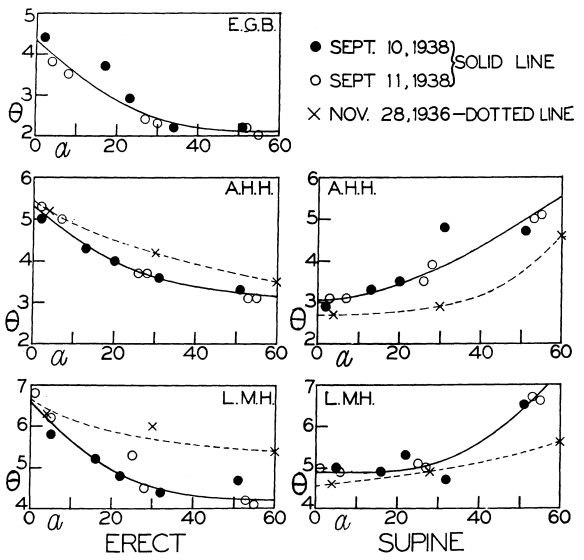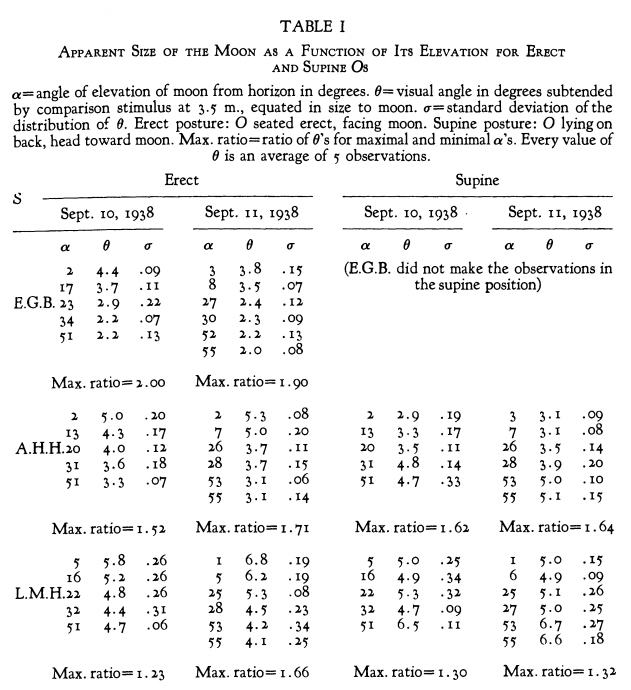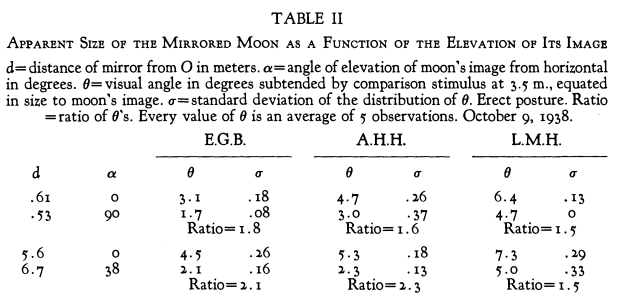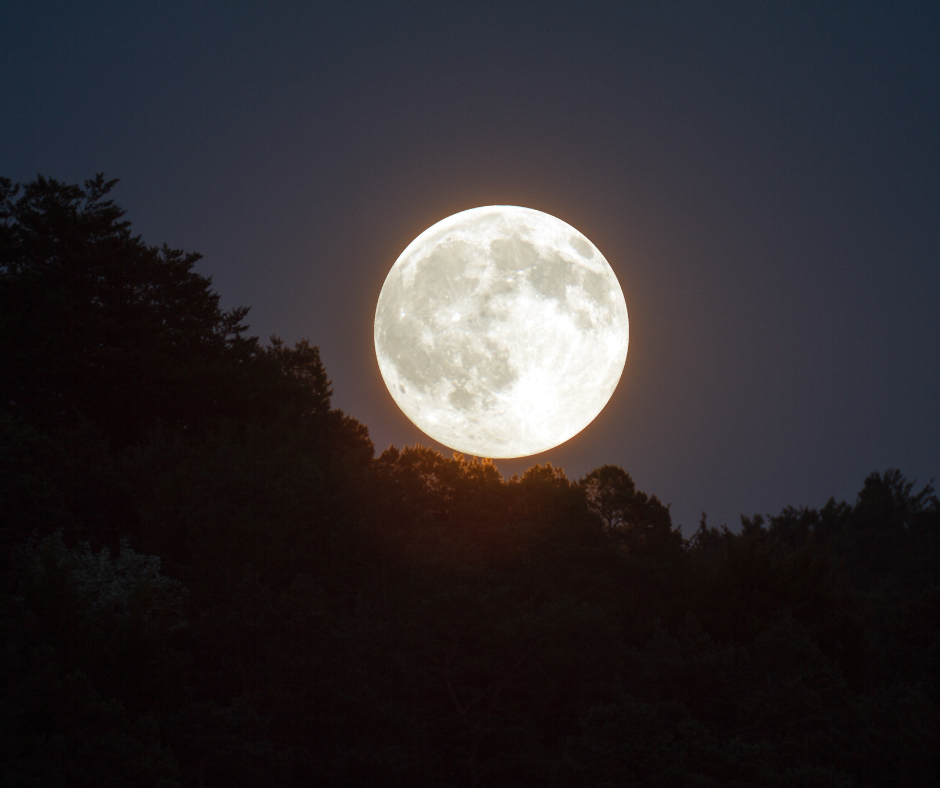Psychology Classics On Amazon

The Moon Illusion and the Angle of Regard
Classic article by Alfred Holway and Edwin Boring
To the erect observer the moon appears large at the horizon and small in culmination. This discrepancy in the appearance of a constant stimulus object has interested philosophers from antiquity, and the history of its consideration has been given elsewhere. That the phenomenon is subjective is demonstrated at once by viewing the horizon moon with the head and eyes in the position which they assume when a standing observer with head inverted regards the horizon between his legs: the moon then seems to be small. The ratio of the diameter of the moon in culmination to the diameter of the moon at the horizon has been found in some experiments to be about 1:2.5, a measurement which, however, includes considerable variation. Zoth's theory has been that the illusion depends upon the position of the eyes, and this view has recently received explication and support by Schur. She showed with artificial moons (projected circles of light) that the amount of the illusion depends directly upon the distance of the stimulus-object. For her the amount of the illusion was measured by the zenith-horizon ratio as 1:1.2 at a distance of 4 m., and it shifted to the ratio 1:2.0 at 33 m., changing by a continuous function that was approximately asymptotic to the ratio 1:2.0. It thus becomes obvious why the illusion is normally astronomical: there are no objects other than the sun, moon and stars which are usually seen by the observer at large constant distances and at greatly varying elevations.
The present paper is a first report of observations which substantiate the generalization that the illusion, occurring for distant objects, is primarily dependent upon the direction of regard-upon the posture of the head and eyes. We have devoted this paper principally to establishing the fact that the illusion depends upon posture, and thus, following the example of our predecessors, we have not separately controlled head and eye movements; but we hope to present such an analysis in a later paper.
ASCENDING MOON: ERECT POSTURE

FIG. 1. APPARENT SIZE OF THE MOON AS A FUNCTION OF ITS ELEVATION FOR ERECT AND SUPINE OBSERVERS
a = elevation of moon above horizon in degrees. 0 = diameter of comparison stimulus (circle of light projected on screen 3.5 m. from O) in degrees of visual angle. Observers: E.G.B., A.H.H., L.M.H. Erect posture: O is seated, body erect, facing the moon, head and eyes elevated as necessary. Supine posture: O lies on back, head toward moon, head and eyes thrown back so as to view the moon. The supine position approximately reverses the posture for the erect position, and thus reverses the illusion.
Our observations of the full moon were made from the roof of the Harvard Biological Laboratories where there is an unobstructed view of an eastern horizon. O sat erect in a chair, facing the moon (with the median plane of the head coinciding with the vertical plane through the moon). O controlled a small projection lantern which projected a circular disk 6f light on a vertical white screen (6 x 6 ft.), placed at one side 3.5 m. away, with its center about at the level of O's eyes. This lantern held a film with circular apertures developed upon it, ranging in 50 successive frames from a size that would give an image of 3-cm. diameter on the screen to an image of 30-cm. diameter. The diameters for the 50 frames varied approximately in a geometrical series, and the intervals between successive images were small. O equated the apparent size of the image on the screen to the apparent size of the moon, using binocular regard, looking back and forth from image to moon, and moving the film back and forth so as first to bracket the correct equivalent size and then to make the equation exact. This final adjustment was a little difficult since it involved the comparison of two sizes at different distances, but the bracketing procedure enabled O constantly to reestablish his certainty by viewing at will sizes that were obviously too small and obviously too large. Usually O was able quickly to narrow his choice to two, or at most three, successive frames.
The moon itself subtends a visual angle of about 31'. It varies almost 2' in either direction from this mean as its distance from the earth changes. We measured the elevation of the moon from the horizon by a porte lumiere, checking the angles by reference to tables, and we reoriented O and the apparatus as the moon southed during its ascension. The two authors (A.H.H. and E.G.B.) and Dr. L. M. Hurvich (L.M.H.) acted as Os.
The determinations of change in apparent lunar diameter are shown in the left half of Table I and the left half of Fig. 1. For the erect O, as the altitude of the moon increases, its apparent size, 0, the angle subtended by the diameter of the equivalent comparison stimulus, decreases. The ratio of the diameter of the comparison stimulus for the moon at the horizon to that for the moon near culmination ("Max. ratio" in Table I) ranges from 1.23 to 2.00. Fig. 1, with its smoothed curves. shows the trend. Each reported value of O is an average of 5 observations, and the critical ratios between the first and last point of each function are large( only one is less than 18).
These results are for observations of the full moon on the evenings of September 10 and 11, 1938. In Fig. 1 other data for A.H.H. and L.M.H. on November 28, 1936 (dotted lines and crosses) are added. When all the data are considered together, consistency is seen to be high. The results of 1938 are consistent with the results of 1936, even in respect of the individual differences between the two Os, both for the apparent size of the moon and for the 'maximal ratio.' For all three Os the functions of September 11, 1938, approximately repeat the functions for the preceding night, and observations are consistent for data taken a few minutes apart (cf. for E.G.B., Sept. 11, 3 with 8·, 27 with 30·, 52 with 55·, and similarly for the other Os). It is seen that these data are consistent with the view that the angle of regard is the chief determinant of the apparent size of the moon, although the elevation of eyes and head were not separately controlled. The eyes can be elevated from the primary position only a little more than 40·, but the moon itself, at latitudes north of 40·, is not often seen at more than 60· above the horizon. Thus the "horizon-zenith" illusion, as it is sometimes called, concerns a difference between no elevation and an elevation which is ordinarily so much less than 90· as to be not much greater than the amount the eyes can be raised without movement of the head. In the present experiment the regard of the moon at its 60·-culmination must have involved at least 15· bending of the neck and quite possibly more.

These judgments involve what has been called the "size-constancy" phenomenon. The moon, about 240,000 miles from O, subtends an angle of about half a degree. The equivalent stimuli, 3.5 m. from 0, subtend angles that vary from 2.0· to 6.8·, that is to say, their retinal images are linearly from four to twelve times as large as the images for the moon. All the images for the near object are larger; none is smaller. When a perceived object changes from far to near, its apparent size increases less rapidly than the retinal image. Conversely, if the apparent size remains the same, then the retinal image of the near object must be larger than the retinal image of the far object.
In this connection it is interesting to note that the artificial moon in use at the Hayden Planetarium in the American Museum of Natural History is made to subtend an angle of 1·, twice as much as the real moon, and it still looks too small to many people.
ASCENDING MOON: SUPINE POSITION
If the elevation of regard from the primary position is the essential condition of the moon illusion, then the phenomenon ought to be reversible. For this reason we placed O supine, lying on his back with his head toward the moon.
To view the horizon moon from this position is difficult. Since the eyes can be raised only about 40·, the 0 must assume the awkward position of bending back his neck and shoulders about 50·, so as partly to invert his head. The task was facilitated on the second night (Sept. 11) by the use of a cot over the end of which the head hung down. At neither time was E.G.B. able to assume this position without nausea, so that observations from him in the supine position had to be abandoned.
The data for A.H.H. and L.M.H. are given in the right half of Table I and the right half of Fig. 1. It is apparent at once that the illusion is reversed under these conditions. The comparison stimulus is small for the moon at the horizon and large for the moon in culmination. It is just about as small for the horizon with supine posture as it is for culmination with the same O in the erect posture; and, conversely, the moon in culmination for the supine position is equated by this measurement to the horizon moon for the erect position. The 'maximal ratios' for the supine posture are of the same size as the ratios for the erect posture.
All the indicators of consistency in the data for the erect posture exist with equal reliability in the data for the supine posture. There can no longer be any doubt that the illusion depends primarily upon the orientation of O to the moon, and is essentially independent of physical variables that lie outside of the observing organism.
The only exception to this generalization lies in the fact that the supine O is not so impressed by the large size of the moon at culmination as is the erect O by the large size of the horizon moon. Measurement shows that the supine O requires just as large a comparison stimulus for the equivalent of the moon in culmination as the erect 0 requires for the horizon moon. Unless the supine O also sees the comparison stimulus as smaller than the erect O sees it, in spite of the fact that his positional relation to it is about the same, then the two moons must be the same apparent size. Perhaps here the much discussed effect of adjacent objects plays a role, and the horizon moon and its comparison equivalent are contrasted with relatively small objects, whereas the moon in culmination and its comparison equivalent are compared only with the huge spaces of the heavenly vault. Such a contrast effect could enter into an 'absolute judgment' of size, without altering the comparative judgment.
MIRRORED MOON
Gauss suggested that the moon illusion be tested by projection of the mirrored image of the moon to different parts of the sky, and many persons, including Helmholtz, have tried this experiment with varying success. If the large horizon moon be viewed in an ordinary mirror held close at hand, it loses its size and appears quite small. That is the common experience. It has been noted, however, that the illusion may be observed if the mirror is distant;5 and it is obvious that the reflection ought to provide the illusion if the mirror can be made irrelevant to the perceptual situation, and that the mirror ought to be irrelevant if it is invisible.
We employed as a mirror a glass plate, 6 x 6 x 1/2 in., worked to an optically flat surface and aluminized on the front surface from edge to edge. It was mounted on a metal plate with narrow blackened clips at the edge, and it was supported by a long blackened rod. This mirror was used in the bright light of the full moon, on the evening of October 9, 1938, on the roof of the Biological Laboratories. At a distance of a half a meter the rod and frame of the mirror were quite obvious, and the mirror surface itself, although, being front-aluminized, it provided no visible glass, nevertheless seemed to be projected to the plane of its frame. At 5 m., however, when reflecting the image of the moon, the mirror and its supports disappeared in the darkness of the night, which became especially dark by contrast to the brilliant image of the moon. Under these circumstances the illusion, measured by the apparent size of the same comparison stimulus as before, was as striking as for the moon seen directly.
The upper half of Table II shows what happened with the mirror only about 0.5 m. away from O for elevations of 0· and 90·. This observation was difficult because the mirror was visible. O found that he tended to adjust his vision to the distance of the mirror, an adjustment which did not cause diplopia for the image of the moon. With effort he could manage to gaze through the mirror to a distant moon, and, when regard thus became more distant, the apparent size of the moon increased. The observations in the table are all for such distant regard. Although the Os were not satisfied with these difficult observations, the ratios show that the illusion occurred almost in its maximal amount.

The lower half of Table II gives the data when the mirror was somewhat more than 5 m. away from 0. We did not find it practicable to raise the mirror 5 m. above the roof on which we were working, but we could clamp the mirror to a stool on top of a chair on top of a chimney, and thus we obtained a maximal elevation of 38·. These observations, with the supports of the mirror invisible in the dark, simulated closely the direct observation of the moon, even to exclamations of surprise called forth by the projection of the lunar image to the horizon. Actually the ratios tend to be slightly larger than those obtained with the real moon (Table I)-as perhaps they ought to be, since in these observations the O was instructed to elevate his eyes without raising his head.
We conclude, therefore, that this illusion can be studied independently of the natural elevation of the moon by the use of a front-surfaced, optically flat mirror, if the support is invisible and if the mirror is placed at a distance of more than 5 m. The moon's image should in this way be projected against the sky. If it is protected against a near visible object, the image is seen more readily at the distance of the object than in the sky through a hole, as it were, in the object.
CONCLUSION
The moon illusion is a function of the angle of regard as referred to the body as a frame of reference. When O shifts from an erect to a supine position, the illusion remains constant with respect to O's body and is reversed with respect to the earth. Thus the moon appears large with regard in the primary position, and the supine O sees the moon smaller at the horizon than in culmination.
Recent Articles
-
When Therapy Stalls: Why Progress Pauses and How to Respond
Nov 07, 25 05:11 AM
When therapy stalls, it can feel like progress has stopped. Psychiatrist Dr. Jason Shimiaie explores why therapy reaches limits, how clinicians can respond, and when to accept stability as success. -
Unparalleled Psychology Advertising Opportunities
Nov 04, 25 05:38 AM
Promote your book, podcast, course, or brand on one of the web's leading psychology platforms. Discover advertising and sponsorship opportunities today. -
The Zeigarnik Effect: Why Unfinished Tasks Stay on Your Mind
Oct 29, 25 07:54 AM
Discover the Zeigarnik Effect - why your brain can’t let go of unfinished tasks, and how understanding it can boost focus, memory, and productivity.
Please help support this website by visiting the All About Psychology Amazon Store to check out an awesome collection of psychology books, gifts and T-shirts.





